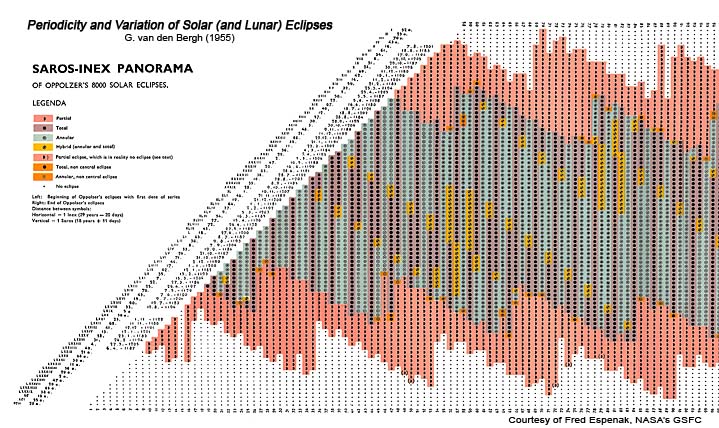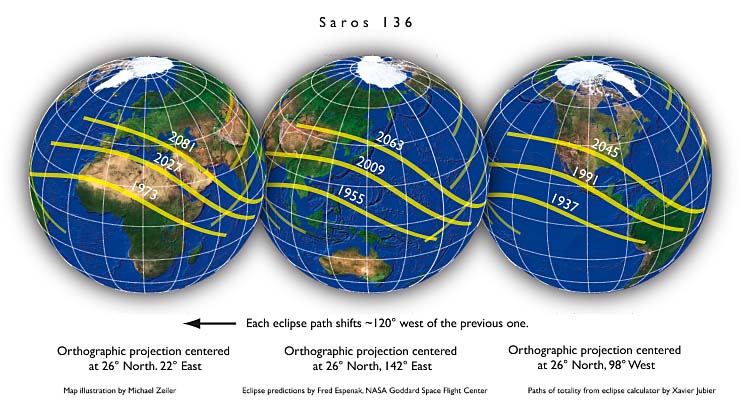Eclipses and the Saros
Fred Espenak
The periodicity and recurrence of eclipses is governed by the Saros cycle, a period of approximately 6,585.3 days (18 years 11 days 8 hours). It was known to the Chaldeans as a period when lunar eclipses seem to repeat themselves, but the cycle is applicable to solar eclipses as well.
The Saros arises from a natural harmony between three of the Moon's orbital periods (circa 2000 CE):
Synodic Month (New Moon to New Moon) = 29.530589 days = 29d 12h 44m 03s
Anomalistic Month (perigee to perigee) = 27.554550 days = 27d 13h 18m 33s
Draconic Month (node to node) = 27.212221 days = 27d 05h 05m 36s
One Saros is equal to 223 synodic months. However, 239 anomalistic months and 242 draconic months are also equal to this same period (to within a couple hours)!
223 Synodic Months = 6585.3223 days = 6585d 07h 43m
239 Anomalistic Months = 6585.5375 days = 6585d 12h 54m
242 Draconic Months = 6585.3575 days = 6585d 08h 35m
Any two eclipses separated by one Saros cycle share very similar geometries. They occur at the same node with the Moon at nearly the same distance from Earth and at the same time of year. Because the Saros period is not equal to a whole number of days, its biggest drawback is that subsequent eclipses are visible from different parts of the globe. The extra 1/3 day displacement means that Earth must rotate an additional ~8 hours or ~120º with each cycle. For solar eclipses, this results in the shifting of each successive eclipse path by ~120º westward. Thus, a Saros series returns to about the same geographic region every 3 saroses (54 years and 34 days).
A Saros series doesn't last indefinitely because the three lunar months are not perfectly commensurate with one another. In particular, the Moon's node shifts eastward by about 0.5º with each cycle. A typical Saros series for a solar eclipse begins when new Moon occurs ~18° east of a node. If the first eclipse occurs at the Moon's descending node, the Moon's umbral shadow will pass ~3500 km below Earth and a partial eclipse will be visible from the south polar region. On the following return, the umbra will pass ~300 km closer to Earth and a partial eclipse of slightly larger magnitude will result. After ten or eleven Saros cycles (about 200 years), the first central eclipse will occur near the south pole of Earth. Over the course of the next 950 years, a central eclipse occurs every 18.031 years (= Saros) but will be displaced northward by an average of ~300 km. Halfway through this period, eclipses of long duration will occur near the equator. The last central eclipse of the series occurs near the north pole. The next approximately ten eclipses will be partial with successively smaller magnitudes. Finally, the Saros series will end a dozen or more centuries after it began at the opposite pole. Due to the ellipticity of the orbits of Earth and the Moon, the exact duration and number of eclipses in a complete Saros is not constant. A series may last 1226 to 1550 years and is comprised of 69 to 87 eclipses, of which about 40 to 60 are central (i.e., total, hybrid or annular). For more information, see Saros Series Statistics.
Solar eclipses that take place near the Moon's ascending node have odd Saros numbers. Each succeeding eclipse in a series shifts progressively southward with respect to the center of Earth. On the other hand, solar eclipses occurring near the Moon's descending node have even Saros numbers. Each succeeding eclipse in a series shifts progressively northward with respect to the center of Earth.

Saros-Inex Panorama
(click for larger figure)
The numbering system used for the Saros series was introduced by the Dutch Astronomer G. van den Bergh in his book Periodicity and Variation of Solar (and Lunar) Eclipses (Tjeenk Willink, Haarlem, Netherlands, 1955). He placed all 8,000 solar eclipses in von Oppolzer's Canon der Finsternisse (1887) into a large two-dimensional matrix. Each Saros series was arranged as a separate column with the eclipses in chronological order. The Saros series columns were then staggered so that the interval between any two eclipses in adjacent columns was 10571.95 days (= 29 years -20 days). This is another important eclipse cycle called the Inex . The resulting Saros-Inex Panorama proved useful in organizing eclipses. For instance, one step down in the panorama is a change of one Saros period (6585.32 days) later, while one step to the right is a change of one Inex period (10571.95 days) later. The rows and columns were then numbered with the Saros and Inex numbers.
Note that the Saros numbering sequence does not depend on when a series begins or ends. In general, the numbering tends to follow the order in which each series peaks. In this context, the peak of a series occurs when the umbral shadow axis passes closest to the center of Earth. Since the duration of each series varies up to several hundred years and the numbering approximately follows the order in which each series peaks, this explains why the first eclipse of a series which peaks later can actually preceed the first eclipse of a series that peaks earlier.
From the Six Millennium Catalog of Solar Eclipses, the column labeled Gamma is the parameter that gives the minimum distance (in Earth radii) of the shadow axis from the center of Earth during each eclipse. Gamma is positive or negative depending on whether the shadow axis passes north or south of Earth's center. Looking at any of the Saros catalogs (e.g., Saros 145) one can see how the value of gamma changes with each eclipse in a series. When gamma reaches its minimum (absolute) value, the series is then at its peak. In the case of Saros 145, the peak occurs with the eclipse of 2342 Mar 08 (gamma=0.008).
Since there are two to five solar eclipses every year, there are approximately forty different Saros series in progress at any one time. For instance, during the later half of the twentieth century, there are 41 individual series and 26 of them are producing central eclipses. As old series terminate, new ones are beginning and take their places.

Eclipses from Saros 145: 1891 through 2053
(click for larger figure)
To illustrate, the ten central solar eclipses (1891, 1909, 1927, 1945, 1963, 1981, 1999, 2017, 2035 and 2053) from Saros 145 are plotted in the figure above. The series began with a partial eclipse near the north pole in 1639. The first central eclipse of the series was an annular eclipse in 1891. It was followed by another annular in 1909. The next event was the first total eclipse in 1927. The total solar eclipse of 1999 August 11 is number 21 of 77 eclipses in Saros 145, and it is the 5th of 41 total eclipses in the series. Each of the subsequent total eclipses shifts southwards. The last total eclipse occurs in 2648 near the south pole. The last eclipse of the series takes place in 3009. The Table of Saros 145 gives details for every eclipse in the series.

Eclipses from Saros 136: 1937 through 2081 (Courtesy on Michael Zeiler)
(click for larger figure)
Saros 136 is another example. The series is of particular interest because it is currently producing the longest total solar eclipses of the 20th and 21st centuries. Nine solar eclipses from Saros 136 are plotted above for the years 1937 through 2081. The westward ~120° shift of each eclipse path is a consequence of the extra 8 hours in the length of the Saros period. The northward shift of each path is due to the progressive motion of the Moon with respect to its descending node at each eclipse.
Saros 136 will produce 71 eclipses over 1262 years in the following order: 8 partial, 6 annular, 6 hybrid, 44 total, and 7 partial.
The Saros cycle for lunar eclipses operates analogously with the solar eclipse Saros. For lunar eclipses, the parameter gamma is the Moon's minimum distance measured with respect to the axis of Earth's shadow (units of Earth radii). Note however, that the Saros numbering is opposite to that for solar eclipses. Lunar eclipses occurring near the Moon's ascending node have even Saros numbers. Each succeeding eclipse in a series shifts progressively southward with respect to the axis of Earth's shadow. Correspondingly, lunar eclipses occurring near the Moon's descending node have odd Saros numbers. Each succeeding eclipse in a series shifts progressively northward with respect to the axis of Earth's shadow. For more information, see Periodicity of Lunar Eclipses.
As mentioned eariler, the Inex, a period of 358 synodic months (29 years minus about 20 days, or 10571.95 days) is another useful eclipse cycle because it marks the time interval between consecutively numbered Saros series. To see a diagram illustrating the relationship between the Saros and Inex cycles over a period of 26,000 years, visit the Saros-Inex Panorama page.
Historically speaking, the word Saros derives from the Babylonian term "sar" which is an interval of 3600 years. It was never used as an eclipse period until English astronomer Edmund Halley adopted it in 1691. According to R. H. van Gent, Halley "...extracted it from the lexicon of the 11th-century Byzantine scholar Suidas who in turn erroneously linked it to an (unnamed) 223-month Babylonian eclipse period mentioned by Pliny the Elder (Naturalis Historia II.10[56])."
For more information on the Saros and other eclipse cycles, see Periodicity of Solar Eclipses.
Return to:
Periodicity of Solar Eclipses
Catalog of Solar Eclipse Saros Series
Six Millennium Catalog of Solar Eclipses
Periodicity of Lunar Eclipses
Catalog of Lunar Eclipse Saros Series
Six Millennium Catalog of Lunar Eclipses
Eclipses and the Moon's Orbit
Links to Additional Solar Eclipse Predictions
- Home - home page of EclipseWise with predictions for both solar and lunar eclipses
- Solar Eclipses - primary page for solar eclipse predictions
- Solar Eclipse Links - detailed directory of links
- Six Millennium Catalog of Solar Eclipses - covers the years -2999 to +3000 (3000 BCE to 3000 CE)
- World Atlas of Solar Eclipse Maps - index page for world eclipse maps covering 5 millennia
- Javascript Solar Eclipse Explorer - calculate all solar eclipses visible from a city
- Thousand Year Canon of Solar Eclipses 1501 to 2500 - link to the publication
- MrEclipse.com - eclipse resources and tips on photography
- Solar Eclipses for Beginners - a primer on solar eclipse basics
- How to Photograph a Solar Eclipse - instructions for imaging an eclipse of the Sun
- MrEclipse Photo Index - an index of solar eclipse photographs
Acknowledgments
Some of the content on this web site is based on the book Thousand Year Canon of Solar Eclipses 1501 to 2500. All eclipse calculations are by Fred Espenak, and he assumes full responsibility for their accuracy. Permission is granted to reproduce data from this page when accompanied by an acknowledgment:
"Eclipse Predictions by Fred Espenak, www.EclipseWise.com"
